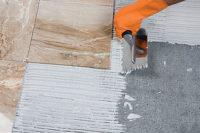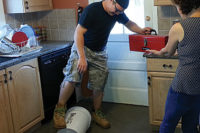
When it comes to working with pads, some of the questions we frequently hear - especially from those that are new to the stone fabrication trade - are: "How do I get a perfect polish on my edges without spending too much time or money?" "With the great variety of polishing pads on the market, how do I know which ones to buy?" "Since all of the pads work in varying degrees, which is best for me?" The answer to these questions is that the perfect polish starts before you ever begin using your polishing pads.
There is nothing worse than drying and examining an edge that you think is "done," only to reveal that there are still scratches deep in the stone. By using a pad that is designed to abrade the scratches left from a saw blade or router bit, the fabricator can eliminate this problem in one or two steps. Honing pads (electroplated or vitrified pads) are made specifically for this purpose. By having all of the diamonds exposed on their surface, these pads can quickly sand any deep scratches remaining from the cutting or shaping process. Honing pads come in a couple of different styles, depending on the manufacturer, but the purpose they serve is the same - scratch removal and conditioning of the edge before the polishing process begins. By comparison, a resin polishing pad is just that, with diamonds suspended in a plastic matrix, which gives the resin pad less aggressive capabilities. While it is true that you can hone with a coarse grit resin pad, they are not really made for this task and will wear out quickly under these circumstances.
Many fabricators make the mistake of going right to a 50-grit resin pad on a piece of stone that just came from the saw or router, and cannot understand why this 50-grit pad wears out quickly and doesn't remove all of the scratches. This is simply a matter of not using the correct pad for the task at hand. The scratch patterns that can be achieved from a 50-grit honing pad are much more aggressive than those from a 50-grit resin pad, which allows the honing pad to remove deep scratches faster and more efficiently. A simple way to illustrate this is to take a honing and resin pad of the same grit, run them side by side for the same amount of time on an edge and observe the results.
When using a honing pad, the fabricator has to be careful not to apply too much pressure to the tool. Usually, the weight of the tool itself is enough to achieve the desired results. Because of the fast cutting nature of these pads, the fabricator runs the risk of putting waves in the edge if too much pressure is applied. Since this is generally unacceptable, honing pads are viewed unfavorably in some circles. But through proper usage, honing pads are an indispensable step that can mean all the difference between a decent edge polish and a great edge polish.

